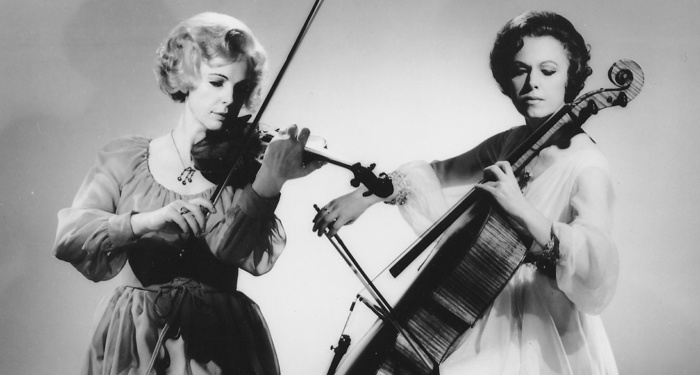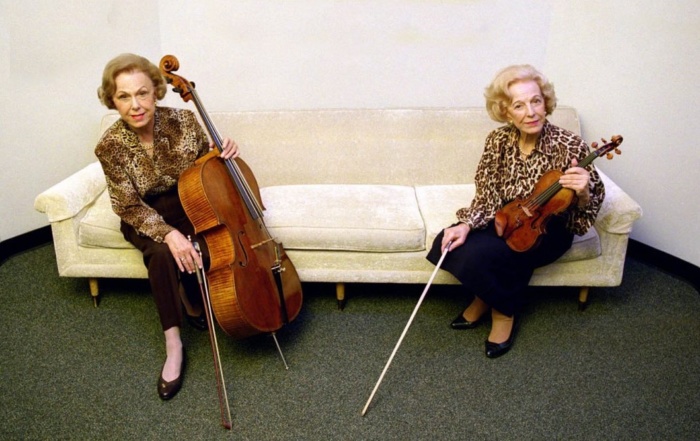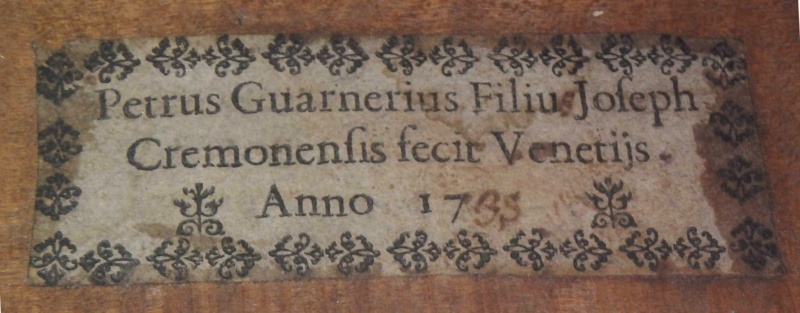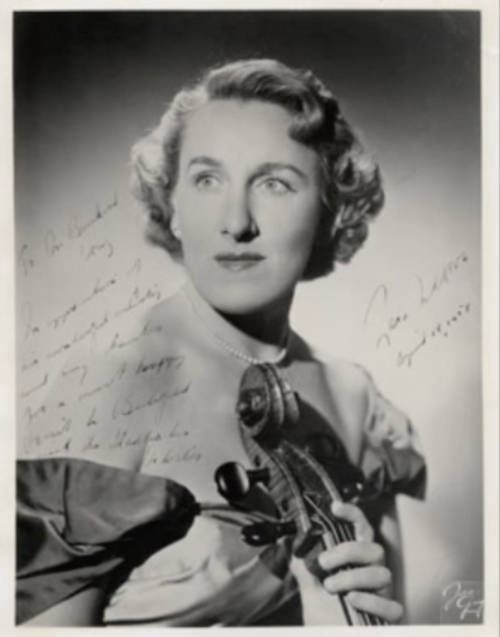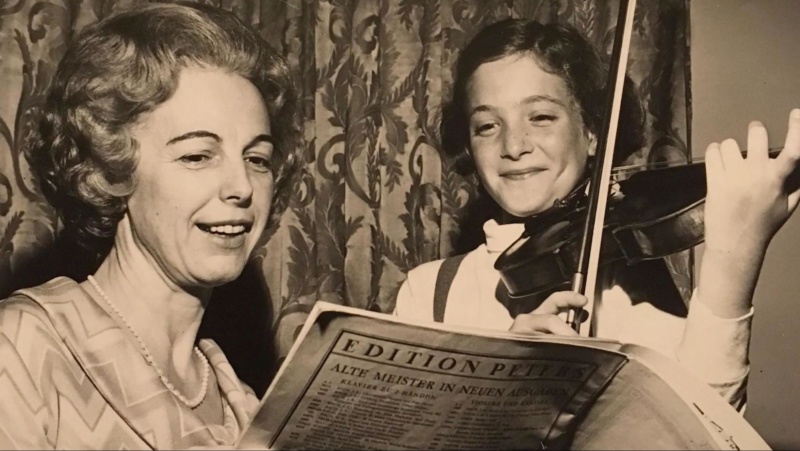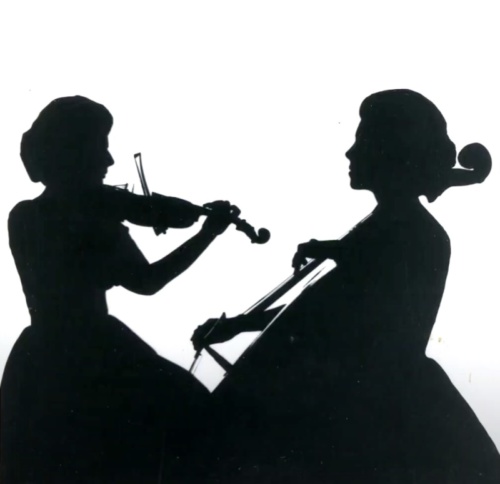Alice and Eleonore Schoenfeld were accomplished players and beloved teachers who mentored legions of students, many of whom are now concertmasters and soloists across the globe. The Schoenfeld sisters taught at the University of Southern California for over fifty years and this year, USC has chosen Tarisio to sell the sisters’ instruments and bows. The Tourte and Peccatte are highlights from our November auction; the two Guarneris are offered by private sale.
The Schoenfeld sisters
Alice was born in 1921, Eleonore in 1925. The precocious sisters grew up in the former Yugoslavia but moved to Berlin in the early 1930s, so that Alice could study the violin with Karl Klingler who himself was a student of Joseph Joachim. Alice later recalled, Klinger “taught me every detail and possibility and freedom of imagination.” [1]
Initially, Eleonore danced for the Berlin Staatsoper. It was “an absolutely fabulous way to be involved with music,” and the experience of being so close to great singers and performers was “incredibly stimulating.” [2]

At eleven, Eleonore switched to the cello. Though she also played piano and violin, her parents convinced her to take up a different stringed instrument as by then, Alice was already a star of the European concert scene. Eleonore advanced so quickly that she gained admission to Berlin’s Hochschule für Musik at age fourteen; the traditional age of matriculation was eighteen. There she worked with Adolph Steiner, a pupil of Hugo Becker.
Alice had her debut with the Berlin Philharmonic at the age of ten, and with Eleonore, she formed the Schoenfeld Duo. Together and individually, they would go on to make hundreds of recordings for the BBC which were played on both radio and television stations across Europe, the United States, Australia and China.
In 1952, following the war, the sisters immigrated to Los Angeles, where they would spend the rest of their lives. They continued to perform and, in 1959, were invited to join the faculty of USC’s Thornton School of Music. Initially, the Schoenfeld sisters both taught part-time so as to continue concertizing but they attracted so many students that it became necessary to become full-time professors. Reflecting on her pedagogical practice, Eleonore explained, “I teach students how to listen, how to recognize a mistake or what needs to be improved technically and musically, and then how to do it correctly or better. The player must first have a specific task in mind and be able to visualize the sound and action necessary to accomplish it. Then he or she tries to do it and evaluates the result …The player practically lives in three time zones—past, present and future. For advanced players, this threefold process takes place almost simultaneously; as they hear the error, they realize what caused the error and know how to fix it.” [3]

The Schoenfeld sisters shared an enduring commitment to music education. As Alice said, ‘It’s a noble profession to be a teacher, every year, and in every aspect.” [4] Their students – now concertmasters, soloists, section players and teachers all across the world – are too numerous to count. Their colleague Ron Leonard called them “institutions within an institution.” [5]
Eleonore Schoenfeld passed away in 2007. In 2012, Alice donated $10 million to USC, of which $3 million was used to renovate what is now known as the Alice and Eleonore Schoenfeld Symphonic Hall. The other $7 million established the Alice and Eleonore Schoenfeld Endowed Scholarship Fund. Alice went on to support international string competitions and the sisters were among the first internationally known musicians to visit China after diplomatic relations were established between the United States’ and Chinese governments. The sisters, through their generous contributions and personal visits abroad, worked to foster connections between musicians internationally.
Alice passed away at age 98 in 2019; she taught at USC for more than five decades. The Schoenfeld sisters never married, instead committing their lives to music and teaching. For most of their lives, Alice and Eleonore lived, taught, worked and performed together. Describing her childhood, Alice said, “We could make music from morning to night,” though this was true for all their lives. [6]
Eleonore’s Pietro Guarneri of Venice cello
Pietro Guarneri, the oldest son of Giuseppe ‘filius Andreae’, should rightly have been first in line to inherit his father’s workshop in Cremona, but after 10 years of apprenticeship in the family business he left for Venice in 1717. Due to Venice’s strict guild requirements, Pietro could not open an enterprise of his own, so instead he took employment in the successful bottega of Matteo Sellas. Guarneri and Sellas had a fruitful collaboration for over a decade and became personally entwined as well, with Sellas standing as godfather for Guarneri’s firstborn son. In 1733 Guarneri set up on his own and the instruments he made over the next two decades are some of the most magnificent instruments ever produced in either Cremonese or Venice. The cellos that he made are particularly notable and rare with fewer than a dozen specimens surviving. This instrument, dating from 1735 is one of finest and best preserved.

The original and indisturbed label deserves our attention and study. The ornamented border incorporates pairs of decorative icons and two floral figures flank the last line of text. We note the manual correction of the typographical error, “filiu” missing its ‘s’. And, significantly, nearly twenty years after he left the family workshop, Pietro still referred to himself as a Cremonese maker, the son of Giuseppe Guarneri.
Venetian violin making, more than any other school in Italy, was a blend of styles and influences. The first wave of makers to come to Venice in the 16th and 17th centuries was from Füssen; later, makers came from the Tyrol and other small towns in the Veneto region; and finally, in the first quarter of the 18th century, Pietro Guarneri arrived from Cremona, Carlo Tononi from Bologna and Sanctus Serafin from Udine. The instruments that were made in Venice in the middle of the 18th century are a fantastic, and at times surprising, mélange of styles and influences.
This cello shows a synthesis of various inspirations. The head closely resembles the work of ‘filius Andreae’ with its blackened chamfers, deeply carved volute and conspicuous gouge marks. The dimensions and outline are similar to those of Guarneri’s contemporary Santo Serafin. The symmetry and precision of the outline and proportions reflects the use of an internal mold, a Cremonese inspiration that Pietro Guarneri brought to Venice. The soundholes have the attenuated stems of ‘filius Andreae’ with stylized wings inspired by a Stainer design. I could spend hours looking at this cello: It is exceptionally elegant, refined, graceful and confident.
Its history dates back to the late 19th century when it came to England from Italy. According to W. E. Hill & Sons, the cello’s original fingerboard and tailpiece were replaced by the London dealer George Withers in c. 1885, indicating that the cello had not previously been modernized.

Zara Nelsova with the Pietro Guarneri in c. 1955.
In around 1950 the cello was acquired by the Canadian-born cellist Zara Nelsova. A child prodigy who was performing with the London Symphony by the age of 12, Nelsova played with some of the greatest orchestras in the world and came to be known as the “Queen of Cellists.”
Many of Nelsova’s most important performances and recordings were made with this cello. A series of important studio recordings for Decca were made between 1950-1956, almost all of which were made on this cello, including concertos by Dvořák, Barber and Lalo, the complete Beethoven Sonatas and Bloch’s Schelomo and From Jewish Life. Bloch was so moved by her rendition of his Schelomo that he declared, “Zara Nelsova is my music” and later dedicated two of his three unaccompanied cello suites to her. In 1951, Nelsova made the first recording of Samuel Barber’s Cello Concerto.
Throughout the 1950s, Nelsova toured the world performing both in recitals and as a soloist. In 1953, she made her first tour of South America and in 1954, Israel. In 1955, she performed an unaccompanied recital in Town Hall in New York City to great acclaim. By the end of 1957, she had completed her first tour of Europe. She played at festivals including Prague, Aspen, Tanglewood, Stanford, Ann Arbor, the Hollywood Bowl, and the Casals Festival in Mexico.
In 1960, Nelsova was given the life-long loan of the 1726 ‘Marquis de Corberon’ Stradivari and she placed this Guarneri for sale with Hans Weisshaar in Los Angeles. Within a matter of months, Weisshaar sold the cello to Eleonore Schoenfeld and it has lived in Los Angeles up until present day.
This cello will be sold by Private Sale. To inquire, please contacts privatesales@tarisio.com.

Eleonore Schoenfeld with the Pietro Guarneri in c. 1965.
Alice’s Guarneri
Alice’s violin was made by Andrea Guaneri, Pietro’s grandfather, in c. 1676. It closely follows the principles and model of Nicolo Amati, Andrea’s teacher. The back is made from a highly-figured log of maple cut on the slab to reveal deep undulating flames. The top is of a fine grained spruce with prominent and attractive haselfichte in the upper and lower bouts. The varnish is a glorious reddish-brown over a bright golden ground with pockets of craqueleur throughout.
Alice acquired this Guarneri from Hans Weisshaar in 1975. Previously it had been in the possession of a series of English owners, three of whom acquired the violin through W. E. Hill & Sons.
The Andrea Guarneri will be sold by Private Sale. To inquire, please contacts privatesales@tarisio.com.

Eleonore’s Peccate
Before Eleonore, this Charles Peccatte was owned by Laurence Lesser. The certificate from Hans Weisshaar in Lesser’s name is dated 1965, one year before he won a prize in the 1966 Tchaikovsky Competition.
It is sold as lot 19 in our November auction in New York.
Alice’s Tourte
In 1975, Alice bought this François Xavier Tourte at Hans Weisshaar. It is sold as lot 128 in our November auction in New York.

- Mike Boehm, “Gift to USC continues legacy of mentoring,” Los Angeles Times, 28 February 2013, https://www.latimes.com/entertainment/arts/la-xpm-2013-feb-28-la-et-cm-alice-schoenfeld-usc-gift-20130301-story.html?fbclid=IwAR3BXRzOPKqEyQGbgRbmlWmqrAdkOqt5aHIO_GRYgEzSA9UNxghoN8FfEkQ
- Tim Janof interviews Eleonore Schoenfeld, Internet Cello Society, 22 August 1999, http://www.cello.org/Newsletter/Articles/schoenfeld.htm
- Ibid
- Op cit. 2013
- John Thurber, “Eleanore Schoenfeld, 81; renowned cellist had taught at USC Thornton School since ’59,” Los Angeles Times, 6 January 2007, https://www.latimes.com/archives/la-xpm-2007-jan-06-me-schoenfeld6-story.html
- Ibid
